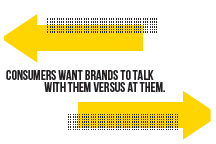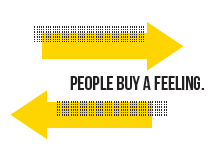When I first started in this business some 30 years ago, we spent a lot of time in upfront planning and strategy to understand consumer needs, wants and behavior, but once the campaign launched,  it was pretty much ‘set it and forget it.’ The tools of that time were fewer and they were one way. So we marketers formed our messages, and it was pretty much a monologue. Today, not so much. Transition from monologue to dialogue.
it was pretty much ‘set it and forget it.’ The tools of that time were fewer and they were one way. So we marketers formed our messages, and it was pretty much a monologue. Today, not so much. Transition from monologue to dialogue.
Not only is there significantly more media fragmentation, more access to data, and 100 times the number of options to reach consumers, but also (and most importantly) the Internet has shifted the power dynamic from marketers to consumers – specifically Web 2.0.
With just a click of a button, consumers can access data from around the world to gain meaningful insights about companies and their products. They can compare products, find lower prices, read reviews and even communicate with other users about product quality and buyer satisfaction.

Iterative planning and execution have become the norm.
While we still do smart planning with a lot better tools at our disposal, the launch of a campaign today is just the beginning. As marketers, we need to monitor conversations, track sentiment, gauge behaviors and assess ongoing performance. And we must optimize or change our efforts on the fly. Overall, each marketing plan and execution has become more iterative.
Beware: consumers can easily disengage.
Contrary to what some would have you believe, traditional media, like TV, radio and print, are not dead. But you can no longer count on traditional advertising alone to capture and keep attention. You need to be where your audience is, with a compelling message that sparks conversation and engagement. And it’s not easy to engage more deeply with consumers when they have the power to so easily disengage.
Find the right place, time and message.
Being at the ‘right place at the right time with the right message’ has always been the goal of marketers. And today, with the wealth of data at our fingertips, we have the ability to do just that. When consumers make brand contact, they seek true one-to-one engagement versus simply a barrage of one-way marketing messages. Consumers want brands to talk with them versus at them. They seek a variety of messaging through a variety of channels that paint a consistent picture of the brand experience you offer.
Consumers can sniff out manipulation a mile away.
Consumers have become increasingly resistant to feeling manipulated, and they will make their views widely known. They will quickly sniff you out if they believe you are using them only for your own benefit, or if something is not authentic. Case in point, recently Starbucks launched the #RaceTogether initiative, which was the company’s diversity and racial equality campaign. While the intent may have been good, the execution was not. And after just one week, and a ton of negative backlash, the effort was pulled.
The more things change, the more the key marketing principles endure.
While the tools of the trade have changed dramatically, and technology will be ever-evolving, the fact is that the basic tenants of marketing hold constant against the odds of change.
Information overload. We need to work hard to give relevant meaning and appropriate context in order to retain the attention of our audience.
 People buy a feeling. The best branding inseparably integrates itself with the consumer’s lifestyle.
People buy a feeling. The best branding inseparably integrates itself with the consumer’s lifestyle.
Existing customers are pure gold. When you engage buyers in the right manner to remind them why they spent money with you in the first place, your company stands an excellent chance of earning a repeat sale.
Creativity is king. Being truly creative is the only way to stand out from the crowd.
Sound marketing planning and strategy helps you succeed. Information is powerful, and building a good marketing strategy starts with understanding the external factors that will affect your business.



